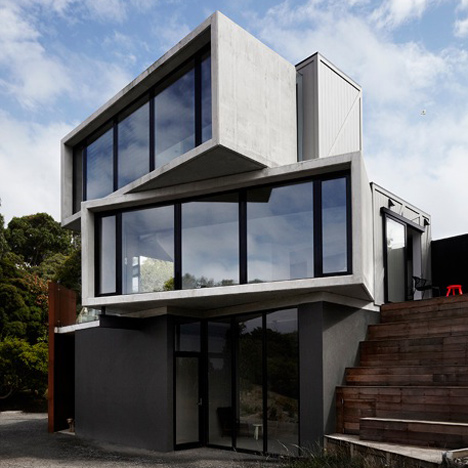
Australian guesthouse by Whiting Architects made up of staggered concrete and timber boxes
Stacked concrete and timber boxes frame the rooms of this guesthouse near Australia's Great Ocean Road, by Melbourne studio Whiting Architects.
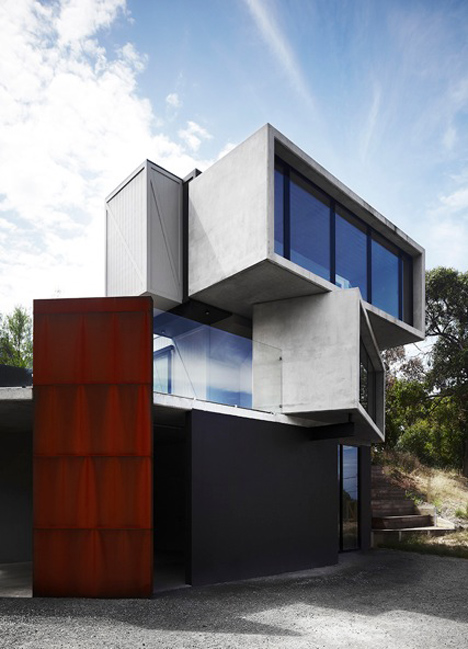
Named The Pod, the building sits on a steep plot overlooking the ocean in the Australian state of Victoria, so Whiting Architects stacked the crate-like boxes on top of each other to catch the best views.
"The house is primarily designed from the inside out for views and sun, but we were also conscious of creating a sculptural form – a man-made imposition on the landscape," said the architects.
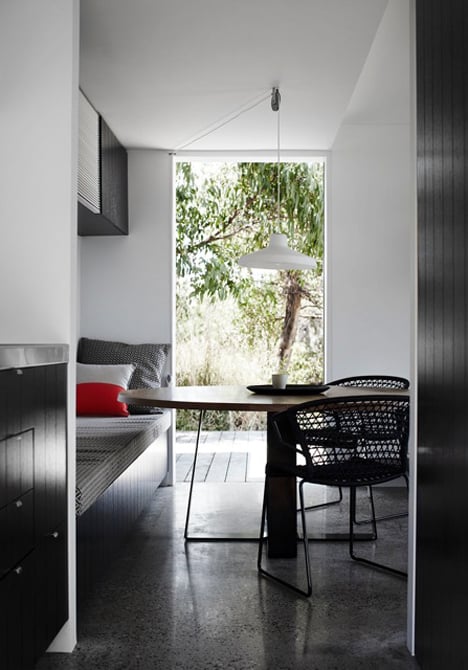
The house is designed as a weekend getaway for a couple, and sits adjacent to a bigger house owned by their extended family. The main street entrance is via large open stairs to the side, which also double as a place for the owners to sit.
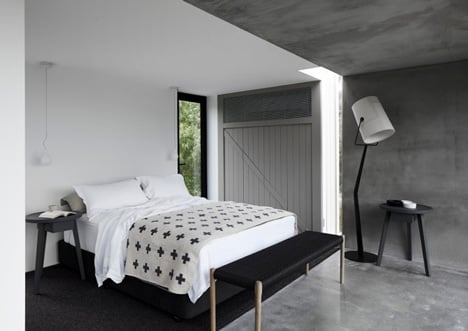
With terraces on three sides, and panoramic indoor viewing areas, residents can make the most of sunlight at different times of the day.
"We worked to create a place that works beyond a gimmick, to offer long-term gratification. It's a place that changes with the seasons, and the time of day," said the architects.
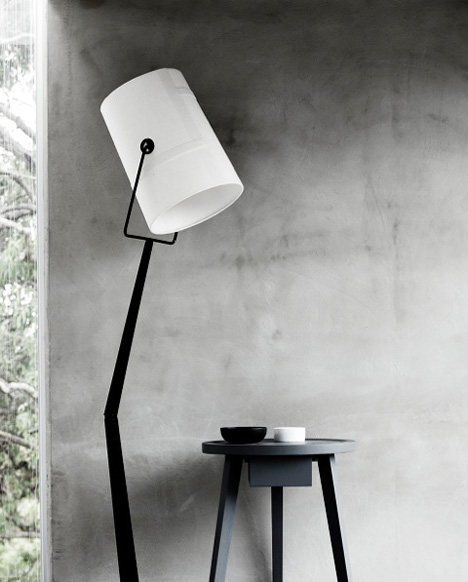
A garage at street level lets the owners drive directly into the house. Stairs lead from here up to the first floor, which has a kitchen, dining area and living room with wide glazing, facing south towards the ocean.
Two terraces on either side of the first floor provide space for the owners to enjoy the views outside, and doors leading to these terraces allows the breeze to flow through the building.
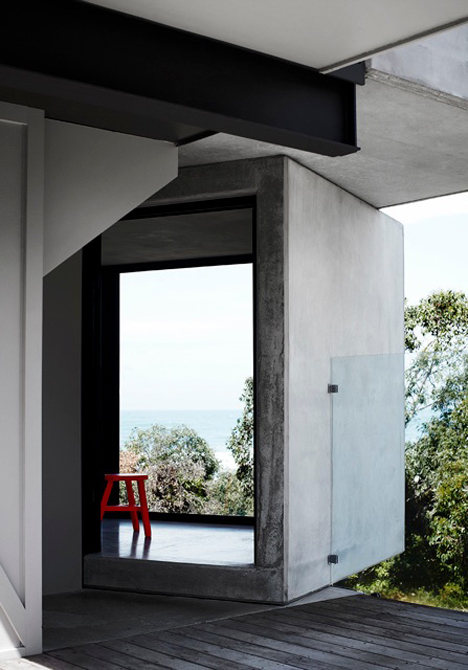
The bedroom on the second floor opens out to a viewing platform, similar to the glazed section in the living room below, but tilted at a different angle. The second floor also has a north-facing terrace behind the bedroom, which attracts direct sunlight throughout the day.
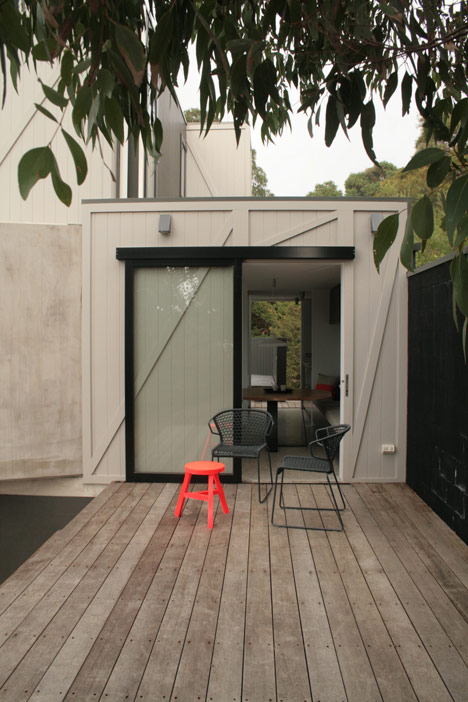
Cool, neutral colours have been used for the interiors, in line with the muted tones of the timber and concrete outside.
"The owners were after a more relaxed feel than the main house, so they could slip in and out on weekends with ease," said the architects.
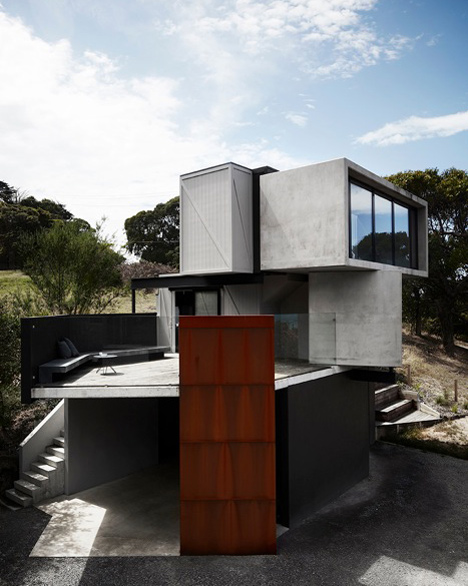
The house is supported by a steel frame, and concrete blocks surround the ground floor. Pre-cast concrete was used for the stacked boxes and the platform that they rest on, which were built off-site and craned in.
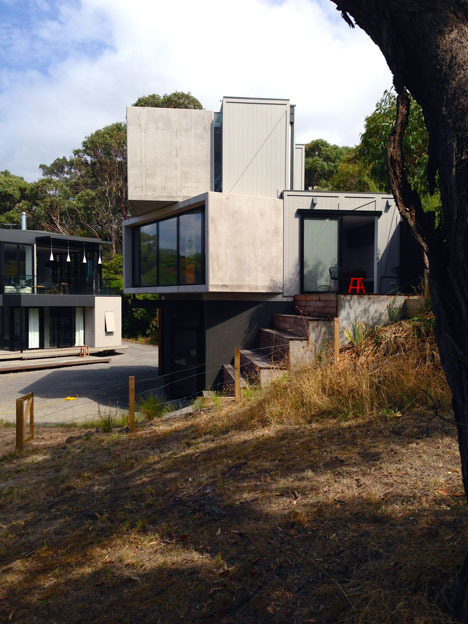
The concrete structure helps to moderate temperatures inside, by naturally soaking up heat from the sun and releasing it slowly as temperatures drop. Glazing has also been angled to maximise sunlight in winter, and opens up to ventilate the house in summer.
"The key was to work with the elements – sun, breezes, shade and shadow – and to get the orientation right," said the architects.
Whiting Architects has also recently completed work on a gabled brick and concrete extension to a home in Melbourne.
Photography is by Sharyn Cairns.
Here is some more information from Whiting Architects:
The Pod
The house is primarily designed from the inside out for views and sun, but we were also conscious of creating a sculptural form – a man-made imposition on the landscape. Not to blend, but to sit in opposition. We removed all trace of archetypal house elements to produce a subtle blurring of the line between art and commerce. Is this freight or a house?
We utilised shade and shadow on form and natural light as a key feature. We maximised natural light and visual access, yet privacy is an issue. We minimised the impact on the landscape. We broke the building into small component parts like stacked boxes, using natural topography to our advantage. The Pod building is an anchor point for the site with crates in timber and concrete randomly stacked as if ready for loading and dispatch by sea. Design came out of the need to overcome a difficult site: steep and split in two by an easement as well as to consider view sharing with adjoining owners and the need to gain elevation and frame views, like a perch or tree house. A small standalone custom-made three-level building for a couple's weekend stays – low-maintenance, eating out, a place to relax and sleep with a deck, and a short walk to town via the beach.
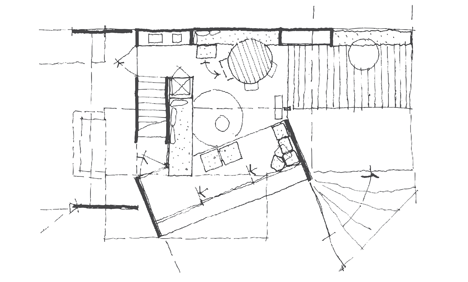
Working from inside-out was easy. We worked to create a place that works beyond a gimmick, to offer long-term gratification. It's a place that changes with the seasons, and the time of day. A place to contemplate, unwind and enjoy. Platforms to enjoy magnificent views. We also had an obligation to create something remarkable when experienced from the outside-in, that reflected our client, his engineering and infrastructure background and what he does. A building with a little client self-expression.
Simply, it works – they love it. It enables them to arrive and inhabit the space effortlessly, a place to navigate to and from.
In an abstract secondary sense, the built form reflects the client and his infrastructure building background. The location is unlike a typical housing site – it is steep, traversed by easements, and it's tapering. It's more like a concrete hard-standing area at the bottom of a block, left for industrial detritus, shipping containers, empty crates. Briefly glimpsed from The Great Ocean Road, it becomes a landmark, a navigation or arrival point. A simple collection of objects to inspire a second look, something to seek out and discover. A counterpoint to the open views of the ocean opposite. We needed to achieve maximum elevation to frame views.
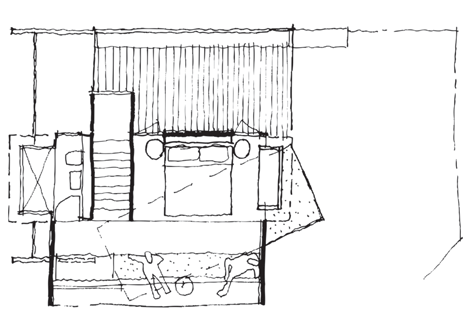
It was a straightforward brief from long-term client and friend. Second Lorne house for them after successful completion of a number of residential and commercial projects. A lot of shorthand and trust. The brief was a collaboration, and so was the build. The engineering was done by the client, and construction was done by their son (who we've had as a client and builder in his own right). The process was punctuated by conversation and good dinners. Never a cross word. Through trust, we were able to introduce aspects that the client would not have imagined. They are delighted by the result and after so many projects together we can honestly say this one is spot-on.
We take a holistic approach to the entire design process. The exterior informs the interior. The building is used as a self-contained guesthouse attached to a main house for a large extended family of three generations. The owners were after a more relaxed feel than the main house, so they could slip in and out on weekends with ease. Neon stools punch out from a mostly neutral background and cooler tones reflect the concrete and timber inside/outside palette.
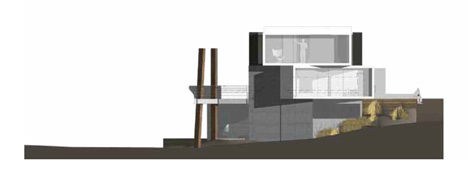
The client is an expert in delivering tunnels under the Yarra and sections of Eastlink, and the design played to the client’s strengths, with concrete and steel, in-filled with lightweight construction clad in compressed cement dressed with straps to give a more three-dimensional look and detract from a standard sheet cladding look. Specialist steel and precast concrete components were formed offsite then craned in, creating an instant platform for the lightweight in-fill and getting us instantly out of the very muddy ground.
The key was to work with the elements – sun, breezes, shade and shadow – and to get the orientation right. We maintained maximum glass, yet kept it sustainable by working with solar heat gain in winter to passively warm areas, offset by the ability to adjust by opening up the entire building to catch sea breezes and allow warm air to escape. Concrete has good thermal-mass properties enabling us to build a combined wall and roof structure in the form of a box, prefabricate it and transport it to site as a completed element. The building achieves a six-star rating.